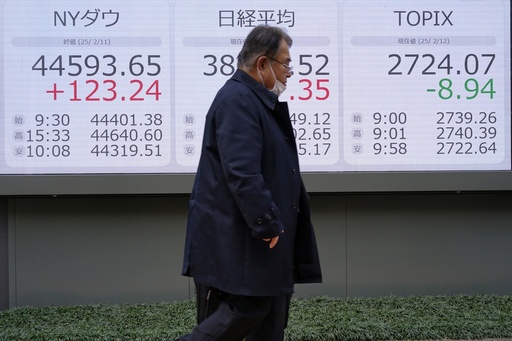
TOKYO — On Wednesday, Asian stock markets experienced a generally positive trend as investors continued to monitor the recent escalation of tariffs announced by President Donald Trump.
The uncertainty surrounding the potential ramifications of these tariffs was palpable among investors. Trump’s decision to impose 25% tariffs on all foreign steel and aluminum imports into the U.S. has heightened concerns, particularly for countries like South Korea, which exports steel to the U.S. However, the potential economic impact may be mitigated for both South Korea and Japan, as they have a more significant volume of exports in other product categories.
Last month, Trump also implemented a 10% duty on all imports from China, adding to the complexity of the international trade landscape.
In midday trading, Japan’s benchmark Nikkei 225 index rose by 0.2% to reach 38,864.96. Meanwhile, Australia’s S&P/ASX 200 index saw a 0.4% increase, hitting 8,519.40, and South Korea’s Kospi index climbed 0.3%, landing at 2,546.41.
In Hong Kong, the Hang Seng index made significant gains, surging by 1.6% to 21,626.80, fueled by ongoing enthusiasm surrounding the company DeepSeek. However, market analysts are left wondering when this rally might reach its zenith. On the other hand, the Shanghai Composite experienced a slight dip, falling less than 0.1% to 3,317.83.
Meanwhile, trading on Wall Street remained relatively modest, with U.S. stocks showing minimal activity, and Treasury yields inching up slightly. The potential for a trade war looms large, with many agreeing that extensive and sustained tariffs could lead to higher costs for American families and significant disruptions for global financial markets.
Despite the threats, the trading environment has remained largely stable, partly due to Trump’s unpredictable approach to tariffs. His past behavior suggests that these tariffs may serve as negotiating tools rather than firm policies. Many on Wall Street are hopeful that the worst outcomes may be avoided.
According to Solita Marcelli, chief investment officer for the Americas at UBS Global Wealth Management, “The metal tariffs may serve as negotiating leverage.”
Federal Reserve Chair Jerome Powell reiterated on Capitol Hill that the Fed is not rushed to further reduce interest rates. The Fed had previously lowered its main interest rate significantly in late 2023 to stimulate the economy, but ongoing inflation concerns have led both the Fed and traders to lower expectations for further cuts in 2025. Some are even speculating that there may be no additional rate reductions, especially considering the uncertain consequences of the tariffs.
Powell commented positively on the economy’s current state, acknowledging the delicate balance between cautious rate cuts and the risk of increasing inflation. Higher interest rates can negatively impact stock prices and the broader economy by making loans more expensive, which poses risks for a U.S. stock market that many believe is already overvalued. The S&P 500 remains close to its historic high set in late September.
A vital method companies can use to counteract downward pressure on their stock prices is to achieve stronger profit results. Recently, many large U.S. corporations have indeed reported robust profits for the last quarter of 2024, although that alone hasn’t always sufficed.
Coca-Cola saw its shares soar by 4.7% after surpassing analysts’ profit and revenue expectations, driven by growth in markets like China, Brazil, and the U.S. Similarly, DuPont’s stock rose by 6.8% following its own better-than-expected profit report.
Overall, the S&P 500 saw a slight increase of 2.06 points or less than 0.1%, reaching 6,068.50. The Dow Jones Industrial Average climbed 123.24 points or 0.3%, finishing at 44,593.65, while the Nasdaq composite underwent a decline of 70.41 points or 0.4%, settling at 19,643.86.
In the bond markets, the yield on the 10-year Treasury note crept up to 4.53% from 4.50%, while the two-year Treasury yield remained unchanged at 4.28%.
In energy markets, the price of benchmark U.S. crude oil slipped by 29 cents to $73.03 a barrel, while Brent crude, the global benchmark, fell by 27 cents to $76.73 a barrel.
In currency exchanges, the U.S. dollar rose slightly against the Japanese yen, trading at 153.64 yen compared to 152.43 yen. The euro’s value held steady, remaining at $1.0363.

